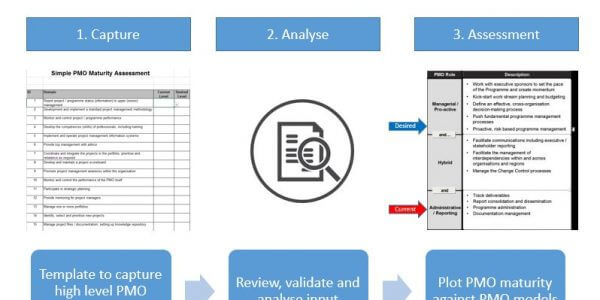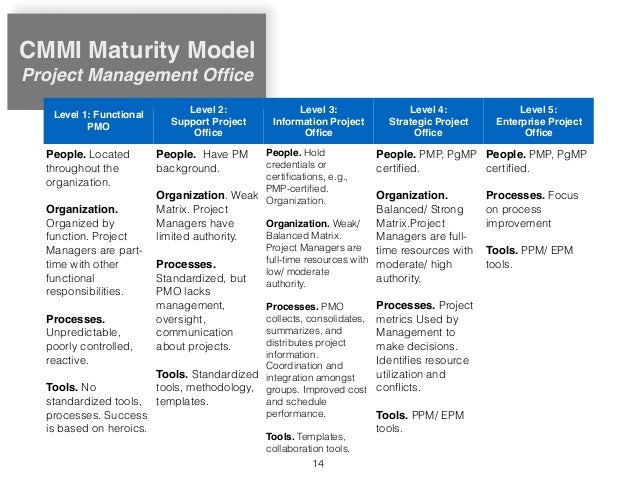- Gartner Pmo Maturity Assessment
- Cmmi Maturity Model Pmo 2020
- Pmo Maturity Model Pmi
- Pmo Maturity Model Gartner
For example, the software industry primarily uses the Capability Maturity Model Integration (CMMI ®). This model was developed by the Software Engineering Institute at Carnegie Mellon University.
The Capability Maturity Model Integration, or CMMI, is a model that helps organizations effectuate process improvement and develop behaviors that decrease risks in service, product, and software development. While CMMI was originally tailored towards software, the latest version is much less specific and can be applied to hardware, software, and service development across all industries. The model enables organizations to measure, build, and improve capabilities and, as a result, to improve overall performance.
The Capability Maturity Model Integration (CMMI ®) is a process and behavioral model that helps organizations create a structure for encouraging productive, efficient behavior.It is designed to help improve performance by providing businesses with the blueprint and methodology for sustained continuous improvement. The Capability Maturity Model contains five stages to evaluate how sophisticated your organization is in establishing and following standard processes. The Five-Stage Capability Maturity Model (CMMI) (A5.1.P2 ) There are some slightly different interpretations of the CMMI. This tool will allow users to quickly and easily assess the maturity level of their PMO. The maturity level is referenced against the 5 Capability Maturity Model Integration(CMMI) levels: Chaotic, Repeatable, Defined, Managed and Optimizing.
A primary goal of CMMI is the creation of “reliable environments where products, services and departments are proactive, efficient and productive.” More specifically, CMMI’s objectives for businesses include enabling the organization to produce quality services or products; increase customer satisfaction; increase value for stockholders; achieve industry-wide recognition for excellence; and build a larger market share. According to the Carnegie Mellon Software Engineering Institute, which was integral in its development, CMMI is intended to help “integrate traditionally separate organizational functions, set process improvement goals and priorities, provide guidance for quality processes, and provide a point of reference for appraising current processes.”
The History of CMMI
CMMI was developed by Carnegie Mellon University as part of the CMMI project. Its goal was to make maturity models – which measure the ability of organizations to have ongoing improvement in a particular area – more effective and usable by integrating a number of models into one framework.

The project, whose main sponsors were the Office of the Secretary of Defense and the National Defense Industrial Association, included members of industry, government, and the Carnegie Mellon Software Engineering Institute (SEI). Models were initially created for the Department of Defense to assess the expertise and quality of software contractors.

The first version of the CMMI was released in 2002 and built upon the Capability Maturity Model (CMM), which was developed from 1987 to 1997. In 2002, version 1.1 was released, in 2006 version 1.2 was released, and in 2010 version 1.3 was released. Version 2.0 launched in 2018 with some notable changes that make the model more accessible and effective for businesses in any industry.
Understanding How CMMI is Applied by Businesses
The CMMI is administered by the CMMI Institute, which was bought by ISACA in 2016. ISACA, now known only by the acronym, previously was known as the Information Systems Audit and Control Association.
The stated goal of the CMMI Institute is to “enable[] organizations to elevate and benchmark performance across a wide range of critical business capabilities, including product development, service excellence, workforce management, data management, supplier management, and cybersecurity.”
Organizations that want to better understand how their practices compare to CMMI best practices and want to implement CMMI practices often start with an appraisal. Generally, a business decides to be appraised to:
- Evaluate how the organization’s processes compare to CMMI best practices and to determine areas of improvement;
- Share information with customers or suppliers about how the organization compares to CMMI best practices; and/or
- Comply with contractual terms of customers.
Appraisals
The appraisal process primarily evaluates three areas: process and service development; service establishment and management; and product and service acquisition. While going through the appraisal process can be time-consuming and expensive for organizations, doing so provides some distinct benefits. An appraisal:
- Helps organizations with the development of an improvement strategy that prioritizes key issues;
- Helps to mitigate risks;
- Showcases the soundness of organizational processes by having results available in the Published Appraisal Results site; and
- Provides the organization with a CMMI maturity level.
Any appraisals using the CMMI model must comply with the requirements in the Appraisal Requirements for CMMI (ARC) document. The official appraisal method used by the CMMI Institute is known as the Standard CMMI Appraisal Method for Process Improvement (SCAMPI). Within this approved method, there are three classes of appraisal methods:
- SCAMPI Class A is the most formal and rigorous type of appraisal and the only type that results in a level rating. Organizations that conduct this type of appraisal usually have already implemented a number of changes and need to benchmark their progress formally. This type of appraisal must be conducted by a certified lead appraiser who works with an on-site appraisal team.
- SCAMPI Class B appraisals are primarily used by organizations that have implemented some changes and want to gauge their progress towards targeted CMMI levels. It’s less formal and less expensive than a Class A Appraisal, but still provides businesses with an opportunity to evaluate progress towards goals.
- SCAMPI Class C appraisals are less expensive, quicker, and more flexible than either Class A or Class B appraisals. The goal of this type of appraisal is to quickly assess a business’s practices and determine how they align with CMMI best practices. Class C appraisals can be used by organizations at a high-level, to analyze organizational issues, or at micro-level, to address more specific or departmental issues.
CMMI Maturity Levels
When a Class A appraisal is done, an organization is awarded either a maturity level rating or a capability level rating. Maturity level ratings range from 1 to 5, with level 5 being the highest level and the goal towards which organizations are working.
Gartner Pmo Maturity Assessment
The five CMMI maturity levels are:

- Initial: processes are seen as unpredictable, poorly controlled, and reactive. Businesses in this stage have an unpredictable environment that leads to increased risks and inefficiency.
- Managed: processes are characterized by projects and are frequently reactive.
- Defined: processes are well-characterized and well-understood. The organization is more proactive than reactive, and there are organization-wide standards that provide guidance.
- Quantitatively Managed: processes are measured and controlled. The organization is using quantitative data to implement predictable processes that meet organizational goals.
- Optimizing: processes are stable and flexible. The organizational focus is on continued improvement and responding to changes.
It’s worth noting that while the goal of organizations is to reach level 5, the model is still applicable and beneficial for organizations that have achieved this maturity level. Organizations at this level are primarily focused on maintenance and improvements, and they also have the flexibility to focus on innovation and to respond to industry changes.
CMMI V2.0
Over time, CMMI has changed primarily in an effort to make models easier for businesses to understand and implement. Additionally, the changes aim to make CMMI more cost-effective for businesses to integrate and use. The newest version, CMMI V2.0 was released in 2018. According to the CMMI Institute, this version was created with the goals of:
Cmmi Maturity Model Pmo 2020
- Improving business performance;
- Better leveraging current best practices;
- Building an agile resiliency and scale; and
- Making the model easier to adopt.
Further, the CMMI institute asserts that version 2.0 will improve customer satisfaction; lead to increased customer acquisition and retention; lead to increased productivity and efficiency; and reduce the risks associated with CMMI.
Pmo Maturity Model Pmi
CMMI V2.0 has five components that are intended to work together to provide businesses with a clear path to achieve their objectives. The five components are training and certification; an appraisal; a simplified model for performance improvements; adoption guidance; and redesigned systems for online resources and tools.
Pmo Maturity Model Gartner
This model is intended to make it easier than ever for businesses to utilize CMMI to improve their overall performance. To learn more about CMMI and about how your business can benefit from this model, visit the CMMI Institute.